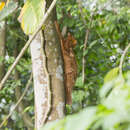ar
الأسماء في صفحات التنقل


The Sunda Flying Lemur (or Sunda Colugo) belongs to the mammalian order Dermoptera. It is now widely (if not universally) accepted that the Dermoptera, along with the Scandentia (tree shrews), are the closest living relatives of the Primates, although the precise relationships among these three groups remain a matter of some debate (Janečka et al. 2007; Arnason et al. 2008; Nie et al. 2008; Asher et al. 2009). These three groups together are sometimes referred to as the Archonta (or Euarchonta) (Asher et al. 2009; Asher and Helgen 2010).
Just two species of colugos are currently recognized, the Philippine Colugo (Cynocephalus volans), found only in the southern Philippines, and the Sunda Colugo (Galeopterus variegates). The Sunda Colugo is endemic to Indochina and Sundaland, an area of the Asian continental shelf that includes the Malay Peninsula and the large islands of Borneo, Sumatra, and Java, as well many smaller islands. Janečka et al. (2008) investigated genetic variation in this broadly distributed species. Based on results from both mitochondrial and nuclear genetic loci, in combination with morphological analyses, they argue that mainland, Javan, and Bornean colugo subspecies may be better recognized as distinct species rather than as subspecies within a single species. (Janečka et al. 2008)
Colugos have a large gliding membrane attached to the neck and sides of the body. This membrane, which extends along the limbs to the tips of the fingers, toes, and tail, is more extensive than in other gliding mammals, whose gliding surface is only stretched between the limbs, with fingers, toes, and tail left free. Colugos are completely arboreal, being nearly helpless on the ground, and are able to travel over 100 meters forward in a single glide, with relatively little loss in elevation. They are generally nocturnal and feed on leaves, buds, flowers, and fruit. (Nowak 1991)
Lim and Ng (2010) estimated the population density of Sunda Colugos in the protected forests of Singapore at around one animal per two hectares, yielding an estimate of roughly 1000 individuals across Singapore's 2000 hectares of protected forest. Lim and Ng note that although colugos have been known to science for two centuries, they have been the subject of remarkably few formal studies. The investigation by Lim and Ng of appropriate methods for estimating population size of these animals is intended in part to facilitate further studies of the biology of these animals.